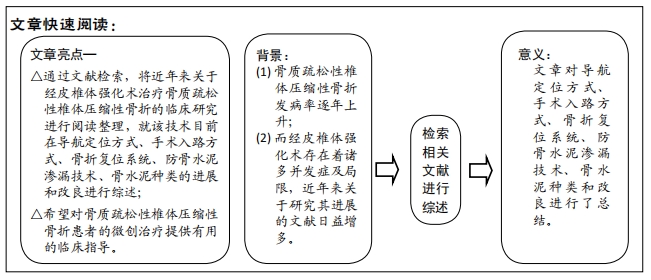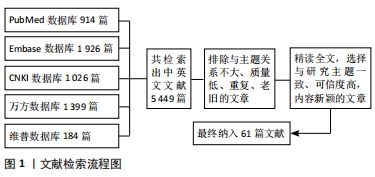[1] ZHU RS, KAN SL, NING GZ, et al. Which is the best treatment of osteoporotic vertebral compression fractures: Balloon kyphoplasty, percutaneous vertebroplasty, or non-surgical treatment? A Bayesian network meta-analysis. Osteoporosis Int. 2019;30(2):287-298.
[2] Laredo JD, Hamze B. Complications of percutaneous vertebroplasty and their prevention. Semin Ultrasound CT MR. 2005;26(2):65-80.
[3] ZHAN Y, JIANG J, LIAO H, et al. Risk factors for cement leakage after vertebroplasty or kyphoplasty: A Meta-Analysis of published evidence. World Neurosurg. 2017;101:633-642.
[4] SHIN M, HUR J, RYU K, et al. Prospective comparison study between the fluoroscopy guided and navigation coupled with o-arm® guided pedicle screw placement in the thoracic and lumbosacral spines. J Spinal Disord Tech. 2015;28(6):E347-E351.
[5] SEMBRANO JN, YSON SC, POLLY DW, et al. Comparison of Nonnavigated and 3-dimensional Image-based Computer Navigated Balloon Kyphoplasty. Orthopedics. 2015;38(1):17-23.
[6] SCHILS F, SCHOOJANS W, STRUELENS L. The surgeon’s real dose exposure during balloon kyphoplasty procedure and evaluation of the cement delivery system: A prospective study. Eur Spine J. 2013;22(8):1758-1764.
[7] SCHILS F. O-arm-guided balloon kyphoplasty: Prospective single-center case series of 54 consecutive patients. Neurosurgery. 2011;68(2 Suppl Operative):s250-s256.
[8] SCHILS F. O-arm guided balloon kyphoplasty: Preliminary experience of 16 consecutive patients. Acta Neurochir Suppl. 2011;109:175-178.
[9] OHNSORGE JAK, SALEM KH, LADENBURGER A, et al. Computer-assisted fluoroscopic navigation of percutaneous spinal interventions. Eur Spine J. 2013;22(3):642-647.
[10] JANG SH, CHO JY, CHOI WC, et al. Novel method for setting up 3D navigation system with skin-fixed dynamic reference frame in anterior cervical surgery. Comput Aided Surg. 2015;20(1):24-28.
[11] 曹臣,陈书连,高延征,等.3D打印辅助经皮椎体成形术治疗老年重度骨质疏松性椎体压缩骨折[J].中华创伤杂志,2018,34(9):799-805.
[12] 倪鹏辉,刘大鹏,张鹰,等.3D打印个体化导向板在经皮椎体成形术中的应用效果观察[J].中国骨与关节损伤杂志,2017,32(11):1131-1134.
[13] LI J, LIN J, YANG Y, et al. 3-Dimensional printing guide template assisted percutaneous vertebroplasty: Technical note. J Clin Neurosci. 2018;52:159-164.
[14] 赵汝岗,张强,赵昌松,等.3D打印经皮导板导航在骨质疏松性椎体压缩骨折经皮椎体后凸成形术中的初步应用[J].中国医师进修杂志, 2016,39(11):1030-1032.
[15] TACK P, VICTOR J, GEMMEL P, et al. 3D-printing techniques in a medical setting: A systematic literature review. Biomed Eng Online. 2016;15(1):115.
[16] CHEN YC, ZHANG L, LI EN, et al. Unilateral versus bilateral percutaneous vertebroplasty for osteoporotic vertebral compression fractures in elderly patients: A meta-analysis. Medicine (Baltimore). 2019;98(8):e14317.
[17] TAN G, LI F, ZHOU D, et al. Unilateral versus bilateral percutaneous balloon kyphoplasty for osteoporotic vertebral compression fractures: A systematic review of overlapping meta-analyses. Medicine (Baltimore). 2018;97(33):e11968.
[18] CHEN X, GUO W, LI Q, et al. Is unilateral percutaneous kyphoplasty superior to bilateral percutaneous kyphoplasty for osteoporotic vertebral compression fractures? Evidence from a systematic review of discordant Meta-Analyses. Pain Physician. 2018;21(4):327-336.
[19] SUN H, LI C. Comparison of unilateral and bilateral percutaneous vertebroplasty for osteoporotic vertebral compression fractures: A systematic review and meta-analysis. J Orthop Surg Res. 2016;11(1):156.
[20] LIEBSCHNER MA, ROSENBERG WS, KEAVENY TM. Effects of bone cement volume and distribution on vertebral stiffness after vertebroplasty. Spine (Phila Pa 1976). 2001;26(14):1547-1554.
[21] WANG S, WANG Q, KANG J, et al. An imaging anatomical study on percutaneous kyphoplasty for lumbar via a unilateral transverse process-pedicle approach. Spine (Phila Pa 1976). 2014;39(9):701-706.
[22] CHENG X, LONG HQ, XU JH, et al. Comparison of unilateral versus bilateral percutaneous kyphoplasty for the treatment of patients with osteoporosis vertebral compression fracture (OVCF): A systematic review and meta-analysis. Eur Spine J. 2016;25(11):3439-3449.
[23] 袁宏,赵喜滨,孙治国.球囊单侧扩张椎体后凸成形术治疗老年骨质疏松性椎体压缩骨折[J].中国脊柱脊髓杂志,2007,17(12):913-917.
[24] 郑博隆,郝定均,闫亮,等.自行研发的可弯曲椎体成形器在椎体成形术治疗骨质疏松性胸椎压缩骨折中的应用[J].中华创伤骨科杂志, 2019,21(10):881-887.
[25] 李玉伟,崔红领,王海蛟.应用可弯曲骨水泥注入器单侧穿刺行经皮椎体成形术的可行性及疗效[J].中华放射学杂志,2017,51(4):293-298.
[26] 熊森,毛克亚,韩振川,等.应用弯角椎体成形装置修复胸腰段骨质疏松性椎体压缩骨折[J].中国组织工程研究,2016,20(17):24456-24462.
[27] KOROVESSIS P, REPANTIS T, MILLER LE, et al. Initial clinical experience with a novel vertebral augmentation system for treatment of symptomatic vertebral compression fractures: A case series of 26 consecutive patients. BMC Musculoskelet Disord. 2011;12:206.
[28] TUTTON SM, PFLUGMACHER R, DAVIDIAN M, et al. KAST study: The kiva system as a vertebral augmentation Treatment-A safety and effectiveness trial: A randomized, noninferiority trial comparing the kiva system with balloon kyphoplasty in treatment of osteoporotic vertebral compression fractures. Spine (Phila Pa 1976). 2015;40(12):865-875.
[29] KOROVESSIS P, VARDAKASTANIS K, REPANTIS T, et al. Balloon kyphoplasty versus KIVA vertebral augmentation—comparison of 2 techniques for osteoporotic vertebral body fractures. Spine(Phila Pa 1976). 2013;38(4):292-299.
[30] BEALL DP, OLAN WJ, KAKAD P, et al. Economic analysis of kiva VCF treatment system compared to balloon kyphoplasty using randomized kiva safety and effectiveness trial (KAST) data. Pain Physician. 2015; 18(3):E299.
[31] BERJANO P, DAMILANO M, PEJRONA M, et al. KIVA VCF system in the treatment of T12 osteoporotic vertebral compression fracture. Eur Spine J. 2014;23(6):1379-1380.
[32] 严蔚明,张平.椎体成形术治疗椎体压缩性骨折的改良进展[J].中国矫形外科杂志,2018,26(18):1692-1696.
[33] WANG D, ZHENG S, LIU A, et al. The role of minimally invasive vertebral body stent on reduction of the deflation effect after kyphoplasty. Spine(Phila Pa 1976). 2018;43(6):E341-E347.
[34] SCHÜTZENBERGER S, SCHWARZ SM, GREINER L, et al. Is vertebral body stenting in combination with CaP cement superior to kyphoplasty? Eur Spine J. 2018;27(10):2602-2608.
[35] WERNER CM, OSTERHOFF G, SCHLICKEISER J, et al. Vertebral body stenting versus kyphoplasty for the treatment of osteoporotic vertebral compression fractures: A randomized trial. J Bone Joint Surg Am. 2013; 95(7):577-584.
[36] ESCHLER A, ENDER SA, ULMAR B, et al. Cementless fixation of osteoporotic VCFs using titanium mesh implants (OsseoFix): Preliminary results. Biomed Res Int. 2014;2014:1-8.
[37] UPASANI VV, ROBERTSON C, LEE D, et al. Biomechanical comparison of kyphoplasty versus a titanium mesh implant with cement for stabilization of vertebral compression fractures. Spine (Phila Pa 1976). 2010;35(19):1783-1788.
[38] ENDER SA, WETTERAU E, ENDER M, et al. Percutaneous Stabilization System Osseofix(R) for Treatment of Osteoporotic Vertebral Compression Fractures - Clinical and Radiological Results after 12 Months. PloS One. 2013;8(6):e65119.
[39] ESCHLER A, ROEPENACK P, ROESNER J, et al. Cementless titanium mesh fixation of osteoporotic burst fractures of the lumbar spine leads to bony healing: Results of an experimental sheep model. Biomed Res Int. 2016;2016:4094161-4094169.
[40] NORIEGA DC, RAMAJO RH, LITE IS, et al. Safety and clinical performance of kyphoplasty and SpineJack® procedures in the treatment of osteoporotic vertebral compression fractures: A pilot, monocentric, investigator-initiated study. Osteoporosis Int. 2016;27(6):2047-2055.
[41] KRÜGER A, OBERKIRCHER L, FIGIEL J, et al. Height restoration of osteoporotic vertebral compression fractures using different intravertebral reduction devices: A cadaveric study. Spine J. 2015;15(5):1092-1098.
[42] ROTTER R, SCHMITT L, GIERER P, et al. Minimum cement volume required in vertebral body augmentation—a biomechanical study comparing the permanent SpineJack device and balloon kyphoplasty in traumatic fracture. Clin Biomech. 2015;30(7):720-725.
[43] NORIEGA DC, RODRIOTAGUEZ-MONSALVE F, RAMAJO R, et al. Long-term safety and clinical performance of kyphoplasty and SpineJack(R) procedures in the treatment of osteoporotic vertebral compression fractures: A pilot, monocentric, investigator-initiated study. Osteoporos Int. 2019;30(3):637-645.
[44] VOGGENREITER G. Balloon kyphoplasty is effective in deformity correction of osteoporotic vertebral compression fractures. Spine (Phila Pa 1976). 2005;30(24):2806-2812.
[45] VERLAAN JJ, VAN DE KRAATS EB, ONER FC, et al. The reduction of endplate fractures during balloon vertebroplasty: A detailed radiological analysis of the treatment of burst fractures using pedicle screws, balloon vertebroplasty, and calcium phosphate cement. Spine (Phila Pa 1976). 2005;30(16):1840-1845.
[46] GEORGY BA. Comparison between radiofrequency targeted vertebral augmentation and balloon kyphoplasty in the treatment of vertebral compression fractures: Addressing factors that affect cement extravasation and distribution. Pain Physician. 2013;16(5):E513.
[47] ACHATZ G, RIESNER H, FRIEMERT B, et al. Biomechanical in vitro comparison of radiofrequency kyphoplasty and balloon kyphoplasty. Eur Spine J. 2017;26(12):3225-3234.
[48] FENG L, SHEN J, FENG C, et al. Comparison of radiofrequency kyphoplasty (RFK) and balloon kyphoplasty (BKP) in the treatment of vertebral compression fractures. Medicine (Baltimore). 2017;96(25): e7150.
[49] LADOR R, DREIANGEL N, BEN-GALIM PJ, et al. A pictorial classification atlas of cement extravasation with vertebral augmentation. Spine J. 2010;10(12):1118-1127.
[50] 赵敏,何承建.骨填充网袋治疗骨质疏松性椎体骨折不愈合的疗效观察[J].中国中医骨伤科杂志,2019,27(12):74-75.
[51] 许勇,官众,李永霞,等.骨填充网袋治疗老年骨质疏松性压缩骨折合并椎体内裂隙征[J].中国组织工程研究,2019,23(10):1477-1482.
[52] HE C, LIU G. Comparison of the efficacy and safety of bone-filling mesh container and simple percutaneous balloon kyphoplasty in the treatment of osteoporotic vertebral compression fractures. Pain Physician. 2018;21(3):259.
[53] 白明,银和平,李树文,等.骨填充网袋修复椎体后壁破损骨质疏松性椎体骨折:可有效防止骨水泥渗漏[J].中国组织工程研究,2014, 18(47):7545-7549.
[54] KANG IG, PARK CI, LEE H, et al. Hydroxyapatite microspheres as an additive to enhance radiopacity, biocompatibility, and osteoconductivity of poly(methyl methacrylate) bone cement. Materials (Basel). 2018; 11(2):258.
[55] TAI C, LAI P, LIN W, et al. Modification of mechanical properties, polymerization temperature, and handling time of polymethylmethacrylate cement for enhancing applicability in vertebroplasty. Biomed Res Int. 2016;2016:1-8.
[56] GAMAL B, TARA S, THOMAS S. Setting properties of four acrylic and two calcium-phosphate cements used in vertebroplasty.J Long Term Eff Med Implants. 2006;16(1):51-59.
[57] SCHÜTZENBERGER S, SCHWARZ SM, GREINER L, et al. Is vertebral body stenting in combination with CaP cement superior to kyphoplasty? Eur Spine J. 2018;27(10):2602-2608.
[58] IGNACIO J, IGNACIO K. Pulmonary Embolism from Cement Augmentation of the Vertebral Body. Asian Spine J. 2018;12(2):380-387.
[59] DHIVYA S, KESHAV NARAYAN A, LOGITH KUMAR R, et al. Proliferation and differentiation of mesenchymal stem cells on scaffolds containing chitosan, calcium polyphosphate and pigeonite for bone tissue engineering. Cell Proliferat. 2018;51(1):e12408.
[60] LODE A, HEISS C, KNAPP G, et al. Strontium-modified premixed calcium phosphate cements for the therapy of osteoporotic bone defects. Acta Biomater. 2018;65:475-485.
[61] HE Z, ZHAI Q, HU M, et al. Bone cements for percutaneous vertebroplasty and balloon kyphoplasty: Current status and future developments. J Orthop Translat. 2015;3(1):1-11.
|


